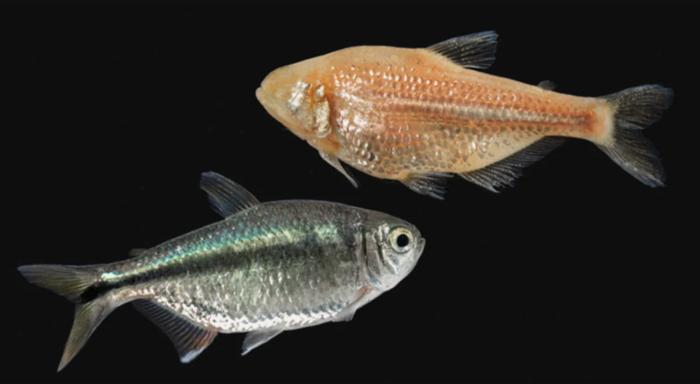KANSAS CITY, MO—March 18, 2024—Fatty liver, which can lead to liver damage and disease, can occur from both overeating and starvation. Now, new research shows how naturally starvation-resistant cavefish, unlike other animals, are able to protect their liver and remain healthy. The findings have implications for understanding and potentially addressing liver conditions in humans.

Credit: Stowers Institute for Medical Research
KANSAS CITY, MO—March 18, 2024—Fatty liver, which can lead to liver damage and disease, can occur from both overeating and starvation. Now, new research shows how naturally starvation-resistant cavefish, unlike other animals, are able to protect their liver and remain healthy. The findings have implications for understanding and potentially addressing liver conditions in humans.
Researchers from the Stowers Institute for Medical Research in collaboration with Université Libre de Bruxelles in Belgium and Iowa State University compared cavefish to other animals more susceptible to starvation, and identified a gene responsible for the development of starvation-induced fatty liver. The study, published in Life Science Alliance on March 11, 2024, led by co-first authors Ansa Cobham, Ph.D., in the lab of Associate Investigator Nicolas Rohner, Ph.D., and Macarena Pozo-Morales, Ph.D., in the lab of Assistant Professor Sumeet Pal Singh, Ph.D., also showed that this evolutionarily conserved gene can be targeted by an existing drug candidate to protect against liver damage.
“This same approach can be applied to what we see in overconsumption,” Rohner said. “In Western societies where, often, too many calories and not enough exercise is a problem, this new understanding may lead to prevention or potential treatment of fatty liver disease.”
“We have discovered for the first time an organism – cavefish—that can avoid fatty liver under starvation conditions,” said Cobham. “Fatty liver can result in complications like liver cirrhosis and liver failure. This study helps us understand more about the biology underlying these diseases in humans.”
Cavefish are cousins of the Mexican tetra river fish that flooded into underground caves over 100,000 years ago. The researchers show that in the absence of food, cavefish at early developmental stages not only survive much longer than their river fish counterparts, but also do not accumulate liver fat.
“This was the first time we clearly showed that the mechanism for this resistance is accomplished by not accumulating excess fat in the liver,” said Rohner.
The accumulation of fat in liver cells leads to organ damage and atrophy or wasting away. The researchers compared gene expression levels between cavefish, river fish, zebrafish, and even fruit flies, identifying a gene that is activated during prolonged periods of starvation in all but cavefish.
“Expression levels of this gene are reduced in cavefish, which is a good indicator that if we are able to target this gene in humans, we may be able to treat or manage human metabolic diseases such as Type 2 diabetes and obesity,” said Cobham.
The team’s findings indicate that the starvation-induced gene not only regulates fatty liver disease, but its mechanism has also been conserved from fruit flies to fish to humans, or approximately 400 million years of animal evolution.
Inhibiting this gene’s protein in zebrafish and river fish larvae and deleting the gene in fruit flies resulted in less liver fat and larger livers indicating this protects the liver from damage and atrophy.
“The collaboration between Dr. Sumeet Singh’s team in Belgium, our team at Stowers, and scientists from Iowa State University combined our collective expertise in zebrafish, cavefish, and fruit flies to uncover the mechanism for starvation-induced fatty liver,” said Rohner.
Additional authors include Cielo Centola, Mary McKinney, Ph.D., Peiduo Liu, Camille Perazzolo, Anne Lefort, Ph.D., Frédérick Libert, Ph.D., and Hua Bai, Ph.D.
This work was funded by Fonds de la Recherche Scientifique (FNRS) (awards: 40005588, 40013427), the National Institutes of Health (NIH) (awards: 1DP2AG071466-01, R24OD030214, R01AG058741, R01AG075156), the National Science Foundation (NSF) (award: 2046984), and institutional support from the Stowers Institute for Medical Research. The content is solely the responsibility of the authors and does not necessarily represent the official views of the NIH.
About the Stowers Institute for Medical Research
Founded in 1994 through the generosity of Jim Stowers, founder of American Century Investments, and his wife, Virginia, the Stowers Institute for Medical Research is a non-profit, biomedical research organization with a focus on foundational research. Its mission is to expand our understanding of the secrets of life and improve life’s quality through innovative approaches to the causes, treatment, and prevention of diseases.
The Institute consists of 21 independent research programs. Of the more than 500 members, over 370 are scientific staff that include principal investigators, technology center directors, postdoctoral scientists, graduate students, and technical support staff. Learn more about the Institute at www.stowers.org and about its graduate program at www.stowers.org/gradschool.
Media Contact:
Joe Chiodo, Head of Media Relations
724.462.8529
[email protected]
Journal
Life Science Alliance
DOI
10.26508/lsa.202302458
Method of Research
Experimental study
Subject of Research
Animals
Article Title
Starvation-resistant cavefish reveal conserved mechanisms of starvation-induced hepatic lipotoxicity
Article Publication Date
11-Mar-2024




